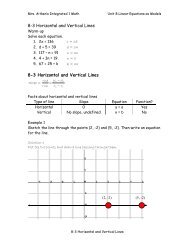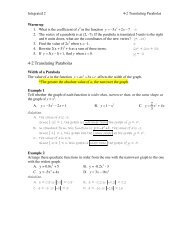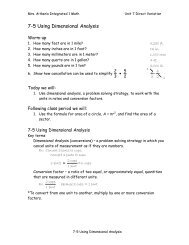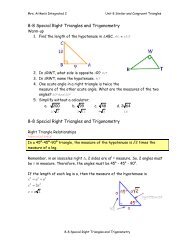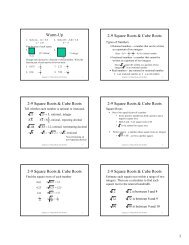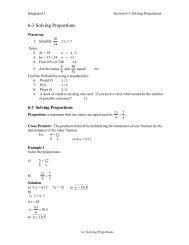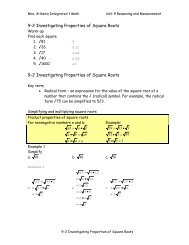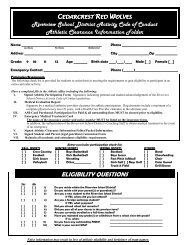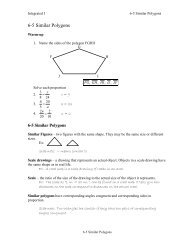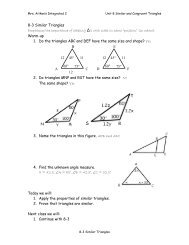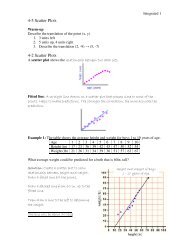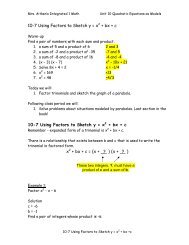8-7 Similarity in Right Triangles 8-7 Similarity in Right Triangles
8-7 Similarity in Right Triangles 8-7 Similarity in Right Triangles
8-7 Similarity in Right Triangles 8-7 Similarity in Right Triangles
You also want an ePaper? Increase the reach of your titles
YUMPU automatically turns print PDFs into web optimized ePapers that Google loves.
Mrs. Aitken’s Integrated 2<br />
Unit 8 Similar and Congruent <strong>Triangles</strong><br />
8-7 <strong>Similarity</strong> <strong>in</strong> <strong>Right</strong> <strong>Triangles</strong><br />
Warm-up<br />
1. Are these triangles similar or not? Why? Similar, AA similarity<br />
postulate<br />
2. F<strong>in</strong>d the value of x <strong>in</strong> the proportion 5 = 10 by cross multiply<strong>in</strong>g.<br />
x 30<br />
x = 15<br />
3. If x 2 = 400, what is x equal to? x = ±20<br />
4. Name three right triangles <strong>in</strong> this figure. ΔACB, ΔADC, ΔBDC<br />
Today and tomorrow we will:<br />
1. Explore properties of right triangles, <strong>in</strong>clud<strong>in</strong>g the Pythagorean<br />
theorem.<br />
2. F<strong>in</strong>d geometric means.<br />
8-7 <strong>Similarity</strong> <strong>in</strong> <strong>Right</strong> <strong>Triangles</strong><br />
Similar right triangles and the Pythagorean theorem<br />
Key term<br />
Altitude – a segment from a vertex of a triangle perpendicular to the l<strong>in</strong>e<br />
conta<strong>in</strong><strong>in</strong>g the opposite side.<br />
Until know, you have used the Pythagorean theorem and its converse without<br />
hav<strong>in</strong>g to prove it. Us<strong>in</strong>g the follow<strong>in</strong>g theorems, we can now prove the<br />
Pythagorean theorem.<br />
8-7 <strong>Similarity</strong> <strong>in</strong> <strong>Right</strong> <strong>Triangles</strong>
Mrs. Aitken’s Integrated 2<br />
Unit 8 Similar and Congruent <strong>Triangles</strong><br />
Similar <strong>Right</strong> <strong>Triangles</strong> theorem<br />
If the altitude is drawn to the hypotenuse of a right triangle, then the two<br />
triangles formed are similar to the orig<strong>in</strong>al triangle and to each other.<br />
C<br />
So, ▲ABC ~ ▲ACD ~ ▲CBD<br />
A<br />
D<br />
B<br />
The Pythagorean Theorem<br />
In any right triangle, the square of the length of the hypotenuse is equal to<br />
the sum of the squares of the lengths of the legs.<br />
c 2 = a 2 + b 2<br />
Example 1<br />
In ΔABC, BD is an altitude to hypotenuse AC. Identify the similar triangles.<br />
Solution 1<br />
ΔACB ~ ΔABD ~ΔBCD<br />
8-7 <strong>Similarity</strong> <strong>in</strong> <strong>Right</strong> <strong>Triangles</strong>
Mrs. Aitken’s Integrated 2<br />
Unit 8 Similar and Congruent <strong>Triangles</strong><br />
Example 2<br />
F<strong>in</strong>d the measure of each unknown side.<br />
a. b.<br />
Solution 2<br />
Use the Pythagorean Theorem because these are right triangles!<br />
a. a 2 + b 2 = c 2 b. a 2 + b 2 = c 2<br />
5 2 +5 2 = c 2 x 2 +x 2 = 4 2<br />
25 + 25 = c 2 2x 2 = 16<br />
50 = c 2 x 2 =8<br />
c = 7.1 x = 2.8<br />
Example 3<br />
In right ΔABC, CD is the altitude to the hypotenuse AB. The measure of
Mrs. Aitken’s Integrated 2<br />
Unit 8 Similar and Congruent <strong>Triangles</strong><br />
Example 4<br />
Write a two-column proof of the Pythagorean theorem<br />
Given: ΔABC with right angle C,<br />
Prove: c 2 = a 2 + b 2<br />
Solution 4<br />
Plan ahead<br />
Draw the altitude of ΔABC from vertex C and label the po<strong>in</strong>t of <strong>in</strong>tersection on AB as<br />
po<strong>in</strong>t D. Use the similar right triangle theorem to identify similar triangles. Then use<br />
the def<strong>in</strong>ition of similar triangles to write proportions <strong>in</strong>volv<strong>in</strong>g the variables a, b, and<br />
c. Use algebra to obta<strong>in</strong> c 2 = a 2 + b 2 .<br />
As an aid, show the correspond<strong>in</strong>g sides of the three similar right triangles.<br />
Statement<br />
1. ΔABC with right angle C 1. Given<br />
2. Draw altitude from C to po<strong>in</strong>t<br />
D on AB<br />
ΔABC ~ ΔACD<br />
ΔABC ~ ΔCBD<br />
Justification<br />
2. If the altitude is drawn to the hypotenuse<br />
of a right triangle, then the two<br />
triangles formed are similar to the<br />
orig<strong>in</strong>al triangle and to each other.<br />
c b c a<br />
3. Def<strong>in</strong>ition of similar triangles.<br />
3. = ; =<br />
b f a e<br />
Correspond<strong>in</strong>g sides are <strong>in</strong> proportion.<br />
4. ce = a 2 ; cf = b 2 4. Multiplication property of equality<br />
5. cf + ce = a 2 + b 2 5. Addition property of equality<br />
6. c(f + e) = a 2 + b 2 6. Distributive property of equality<br />
7. e + f = c 7. For any segment, the measure of the<br />
whole is equal to the sum of the measures<br />
of its non-overlapp<strong>in</strong>g parts<br />
8. c(c) = a 2 + b 2 or c 2 = a 2 + b 2 8. Substitution property (Steps 6 & 7)<br />
8-7 <strong>Similarity</strong> <strong>in</strong> <strong>Right</strong> <strong>Triangles</strong>
Mrs. Aitken’s Integrated 2<br />
Unit 8 Similar and Congruent <strong>Triangles</strong><br />
Geometric Mean<br />
The Geometric mean of two numbers, a and b, is the positive square root of<br />
their product, √ab.<br />
The geometric mean can be expressed as a proportion. The value of x<br />
(geometric mean) <strong>in</strong> the proportion<br />
a x<br />
= , where a, b, and x are positive numbers. x is the geometric mean between<br />
x b<br />
a and b<br />
4 6<br />
Example: 6 is the geometric mean between 4 and 9, s<strong>in</strong>ce =<br />
6 9 .<br />
The Arithmetic mean of two numbers, a and b, is the number half-way between the<br />
two numbers, (a + b)/2.<br />
The geometric mean is always positive.<br />
Example 1<br />
F<strong>in</strong>d the geometric mean between 2 and 72.<br />
Solution 1<br />
a x<br />
Use =<br />
x b .<br />
2 x<br />
So, = , solve by cross multiply<strong>in</strong>g<br />
x 72<br />
2• 72 = x • x<br />
2<br />
144 = x<br />
144 =<br />
x = 12<br />
2<br />
x<br />
The geometric mean is 12.<br />
Example 2<br />
10 is the geometric mean between 25 and what other number?<br />
Solution 2<br />
a x<br />
Use =<br />
x b .<br />
8-7 <strong>Similarity</strong> <strong>in</strong> <strong>Right</strong> <strong>Triangles</strong>
Mrs. Aitken’s Integrated 2<br />
Unit 8 Similar and Congruent <strong>Triangles</strong><br />
25 10<br />
So, = , solve by cross multiply<strong>in</strong>g<br />
10 b<br />
25 10<br />
=<br />
10 b<br />
25b<br />
= 100<br />
b = 4<br />
So, 10 is the geometric mean between 4 and 25.<br />
Geometric Mean Theorem<br />
If the altitude is drawn to the hypotenuse of a right triangle, then the<br />
measure of the altitude is the geometric mean between the measures of the<br />
parts of the hypotenuse.<br />
C<br />
AD<br />
CD<br />
CD<br />
=<br />
BD<br />
A<br />
D<br />
B<br />
Example 3<br />
F<strong>in</strong>d the lengths x, y, and z.<br />
Solution 3<br />
First f<strong>in</strong>d x. Use the geometric mean theorem to write a<br />
proportion <strong>in</strong>volv<strong>in</strong>g x because x is the altitude of ΔABC.<br />
6.5 x<br />
=<br />
x 26<br />
2<br />
x = 169<br />
x = 13<br />
Use the value of x and the Pythagorean theorem to f<strong>in</strong>d y.<br />
2 2 2<br />
y = x + 26<br />
2 2 2<br />
y = 13 + 26<br />
2<br />
y = 845<br />
y ≈ 29.1<br />
Use the value of x and the Pythagorean theorem to f<strong>in</strong>d z.<br />
8-7 <strong>Similarity</strong> <strong>in</strong> <strong>Right</strong> <strong>Triangles</strong>
Mrs. Aitken’s Integrated 2<br />
Unit 8 Similar and Congruent <strong>Triangles</strong><br />
z = x + 6.5<br />
2 2 2<br />
z = 13 + 6.5<br />
2 2 2<br />
2<br />
z = 211.25<br />
z = 14.5<br />
The lengths of x, y, and z are 13, about 29.1, and about 14.5.<br />
Example 4<br />
F<strong>in</strong>d the lengths of m, n, and p.<br />
Solution 4<br />
a x<br />
=<br />
x b<br />
First f<strong>in</strong>d m.<br />
12 m<br />
=<br />
m 3<br />
2<br />
m = 36<br />
2<br />
m =<br />
m = 6<br />
36<br />
Use the Pythagorean theorem to f<strong>in</strong>d n and p.<br />
2 2<br />
12 + 6<br />
2<br />
= p<br />
2 2<br />
6 + 3<br />
2<br />
= n<br />
2<br />
144+ 36 = p<br />
2<br />
180 = p<br />
2<br />
36 + 9 = n<br />
2<br />
45 = n<br />
180 =<br />
2<br />
p<br />
p = 6 5 = 13.4<br />
2<br />
45 = n<br />
n = 3 5 = 6.7<br />
8-7 <strong>Similarity</strong> <strong>in</strong> <strong>Right</strong> <strong>Triangles</strong>



